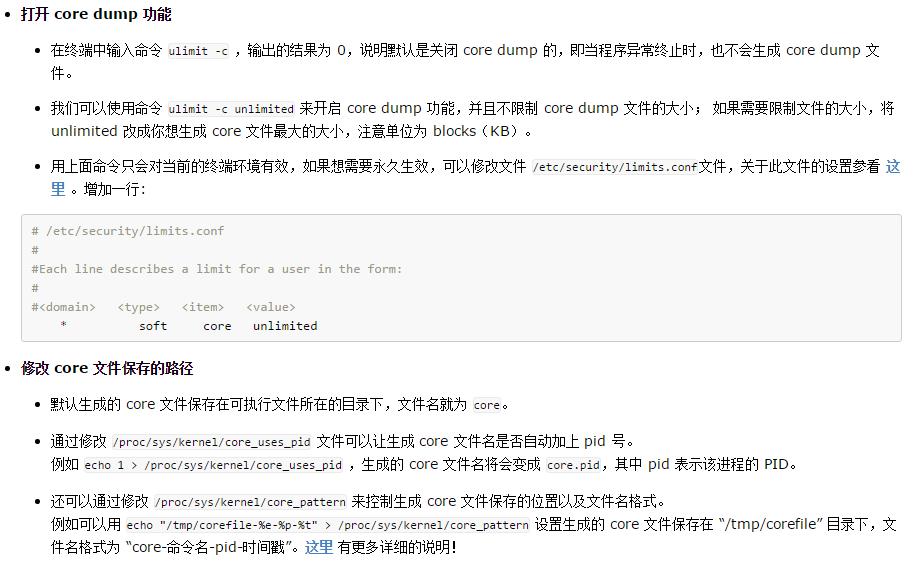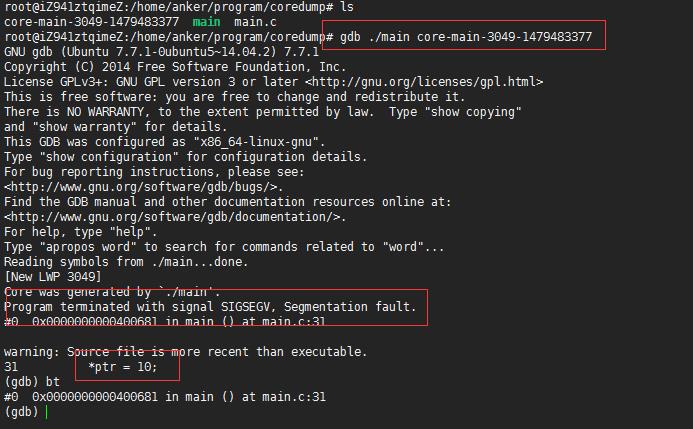centos7下怎样产生core文件
Posted
tags:
篇首语:本文由小常识网(cha138.com)小编为大家整理,主要介绍了centos7下怎样产生core文件相关的知识,希望对你有一定的参考价值。
参考技术A 在Unix系统下,应用程序崩溃,一般会产生core文件,如何根据core文件查找问题的所在,并做相应的分析和调试,是非常重要的,本文对此做简单介绍。例如,一个程序cmm_test_tool在运行的时候发生了错误,并生成了一个core文件,如下:
-rw-r–r– 1 root cmm_test_tool.c
-rw-r–r– 1 root
cmm_test_tool.o
-rwxr-xr-x 1 root cmm_test_tool
-rw--- 1 root
core.19344
-rw--- 1 root core.19351
-rw-r–r– 1 root
cmm_test_tool.cfg
-rw-r–r– 1 root cmm_test_tool.res
-rw-r–r– 1 root
cmm_test_tool.log
[root@AUTOTEST_SIM2 mam2cm]#
就可以利用命令gdb进行查找,参数一是应用程序的名称,参数二是core文件,运行
gdb
cmm_test_tool core.19344结果如下:
[root@AUTOTEST_SIM2 mam2cm]# gdb cmm_test_tool core.19344
GNU gdb Red Hat
Linux (5.2.1-4)
Copyright 2002 Free Software Foundation, Inc.
GDB is free
software, covered by the GNU General Public License, and you are
welcome to
change it and/or distribute copies of it under certain conditions.
Type “show
copying” to see the conditions.
There is absolutely no warranty for GDB. Type
“show warranty” for details.
This GDB was configured as
“i386-redhat-linux”…
Core was generated by `./cmm_test_tool’.
Program
terminated with signal 11, Segmentation fault.
Reading symbols from
/lib/i686/libpthread.so.0…done.
Loaded symbols for
/lib/i686/libpthread.so.0
Reading symbols from
/lib/i686/libm.so.6…done.
Loaded symbols for /lib/i686/libm.so.6
Reading
symbols from /usr/lib/libz.so.1…done.
Loaded symbols for
/usr/lib/libz.so.1
Reading symbols from
/usr/lib/libstdc++.so.5…done.
Loaded symbols for
/usr/lib/libstdc++.so.5
Reading symbols from
/lib/i686/libc.so.6…done.
Loaded symbols for /lib/i686/libc.so.6
Reading
symbols from /lib/libgcc_s.so.1…done.
Loaded symbols for
/lib/libgcc_s.so.1
Reading symbols from /lib/ld-linux.so.2…done.
Loaded
symbols for /lib/ld-linux.so.2
Reading symbols from
/lib/libnss_files.so.2…done.
Loaded symbols for /lib/libnss_files.so.2
#0
0×4202cec1 in __strtoul_internal () from
/lib/i686/libc.so.6
(gdb)
进入gdb提示符,输入where,找到错误发生的位置和堆栈,如下:
(gdb) where
#0 0×4202cec1 in __strtoul_internal () from
/lib/i686/libc.so.6
#1 0×4202d4e7 in strtoul () from
/lib/i686/libc.so.6
#2 0×0804b4da in GetMaxIDFromDB (get_type=2,
max_id=0×806fd20) at cmm_test_tool.c:788
#3 0×0804b9d7 in ConstrctVODProgram
(vod_program=0×40345bdc) at cmm_test_tool.c:946
#4 0×0804a2f4 in
TVRequestThread (arg=0×0) at cmm_test_tool.c:372
#5 0×40021941 in
pthread_start_thread () from /lib/i686/libpthread.so.0
(gdb)
至此,可以看出文件出错的位置是函数 GetMaxIDFromDB
,两个参数分别是2和0×806fd20,这个函数位于源代码的788行,基于此,我们就可以有针对性的找到问题的根源,并加以解决。本回答被提问者采纳 参考技术B 小阿妹想情郎
linux下core dump总结
1、前言
一直在从事linux下后台开发,经常与core文件打交道。还记得刚开始从事linux下开发时,程序突然崩溃了,也没有任何日志。我不知所措,同事叫我看看core,我却问什么是core,怎么看。同事鄙视的眼神,我依然在目。后来学会了从core文件中分析原因,通过gdb看出程序挂再哪里,分析前后的变量,找出问题的原因。当时就觉得很神奇,core文件是怎么产生的呢?难道系统会自动产生,可是我在自己的linux系统上面写个非法程序测试,并没有产生core问题?这又是怎么回事呢?今天在ngnix的源码时候,发现可以在程序中设置core dump,又是怎么回事呢?在公司发现生成的core文件都带有进程名称、进程ID、和时间,这又是怎么做到的呢?今天带着这些疑问来说说core文件是如何生成,如何配置。
2、基本概念
当程序运行的过程中异常终止或崩溃,操作系统会将程序当时的内存状态记录下来,保存在一个文件中,这种行为就叫做Core Dump(中文有的翻译成“核心转储”)。我们可以认为 core dump 是“内存快照”,但实际上,除了内存信息之外,还有些关键的程序运行状态也会同时 dump 下来,例如寄存器信息(包括程序指针、栈指针等)、内存管理信息、其他处理器和操作系统状态和信息。core dump 对于编程人员诊断和调试程序是非常有帮助的,因为对于有些程序错误是很难重现的,例如指针异常,而 core dump 文件可以再现程序出错时的情景。
3、开启core dump
可以使用命令ulimit开启,也可以在程序中通过setrlimit系统调用开启。

程序中开启core dump,通过如下API可以查看和设置RLIMIT_CORE
#include <sys/resource.h> int getrlimit(int resource, struct rlimit *rlim); int setrlimit(int resource, const struct rlimit *rlim);
参考程序如下所示:
#include <unistd.h> #include <sys/time.h> #include <sys/resource.h> #include <stdio.h> #define CORE_SIZE 1024 * 1024 * 500 int main() { struct rlimit rlmt; if (getrlimit(RLIMIT_CORE, &rlmt) == -1) { return -1; } printf("Before set rlimit CORE dump current is:%d, max is:%d\\n", (int)rlmt.rlim_cur, (int)rlmt.rlim_max); rlmt.rlim_cur = (rlim_t)CORE_SIZE; rlmt.rlim_max = (rlim_t)CORE_SIZE; if (setrlimit(RLIMIT_CORE, &rlmt) == -1) { return -1; } if (getrlimit(RLIMIT_CORE, &rlmt) == -1) { return -1; } printf("After set rlimit CORE dump current is:%d, max is:%d\\n", (int)rlmt.rlim_cur, (int)rlmt.rlim_max); /*测试非法内存,产生core文件*/ int *ptr = NULL; *ptr = 10; return 0; }
执行./main, 生成的core文件如下所示

GDB调试core文件,查看程序挂在位置。当core dump 之后,使用命令 gdb program core 来查看 core 文件,其中 program 为可执行程序名,core 为生成的 core 文件名。

4、参考资料
http://www.cnblogs.com/hazir/p/linxu_core_dump.html
http://www.cnblogs.com/niocai/archive/2012/04/01/2428128.html
以上是关于centos7下怎样产生core文件的主要内容,如果未能解决你的问题,请参考以下文章